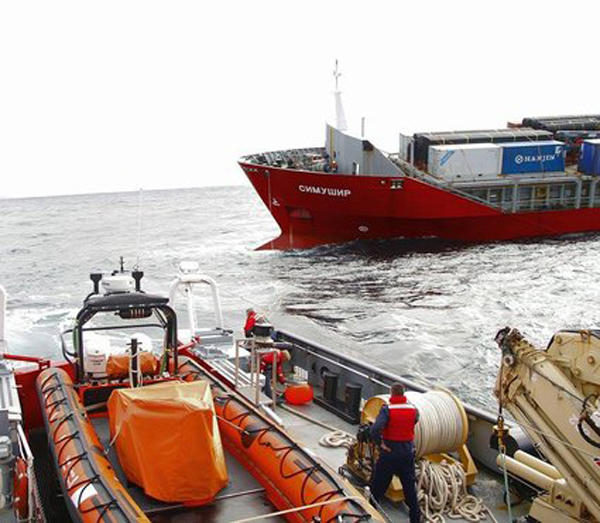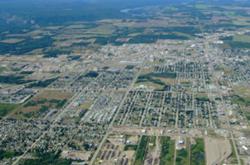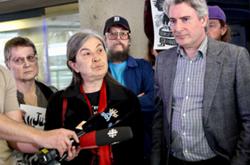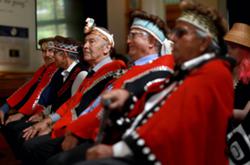[Editor’s note: Last October, a Russian cargo ship carrying hundreds of tonnes of bunker fuel lost power and drifted toward British Columbia's west coast. Disaster was averted when a Canadian Coast Guard vessel managed to pull it away from shore. In this exclusive feature, journalist Jessica McDiarmid recreates the dramatic hours -- on land and sea -- as rescue vessels raced toward the stricken ship.]
It was still an hour before daylight in Victoria, B.C., when the news came in to the Joint Rescue Co-ordination Centre (JRCC) that the captain had been hurt.
The commander of the 134-metre Russian freighter adrift in stormy seas off the west coast of Haida Gwaii, 800 kilometres to the north, had fallen on the pitching ship. His face was in bad shape -- a broken nose -- along with a dislocated finger and a leg injury.
"He was incapacitated, which complicated things," said Jeff Olsson, acting regional supervisor for search and rescue at the JRCC, "because he was the best English speaker on board."
There was no medical treatment on the Simushir, beyond rudimentary first aid. The ship had lost its command -- the captain would need to be airlifted. And the weather out there was ugly, getting worse, as the freighter carrying hundreds of tons of fuel, along with mining equipment and chemicals, drifted closer to the shoreline of Haida Gwaii.
The JRCC declared a mayday.
* * *
Canada's northwestern coast is a vast place, rugged and empty, frequently battered by storms that bring some of the world's fiercest seas. Many of the tiny communities that dot its shoreline are inaccessible by road; whether they can be reached by air or sea depends on the wind, the waves -- the weather. The west coast of Haida Gwaii, an archipelago of islands that form Canada's westernmost point, is often marked in red -- high risk -- on marine risk assessment maps, due in part to probable emergency response times.
By the time the JRCC -- a joint operation of the Canadian Coast Guard and military that co-ordinates search and rescue in the province -- declared a mayday, it had already dispatched Coast Guard ships; U.S. counterparts in Alaska had a boat, helicopters and gear on the way. Emergency co-ordinators had spent the early morning hours trying to arrange for a commercial tugboat to get en route, a process that took hours of phone calls and haggling.
But in this part of the world, it is not unusual for help to be hours, even days, away. And whether it can do anything when it gets there depends, too, on the vessel that responds and the conditions at sea.
While the two American states that border British Columbia -- Alaska and Washington -- have dedicated rescue tugs on-call to respond to emergencies, Canada's west coast does not, relying instead on the far cheaper option of commercial tugboats which, if luck is had, are nearby.
Proposed pipelines that would run from Albertan oil fields to the Pacific would bring super-size oil tankers to the B.C. waters by the hundreds; they would also bring with them escort tug boats, high-powered vessels that would see the tankers in and out of coastal channels. To some, more tugs on the coastline would make these pristine waters safer; to others, more tankers would bring impending disaster.
When the Simushir -- a cargo ship carrying about 400 tonnes of bunker fuel and 60 tonnes of diesel, along with hundreds of containers -- broke down late at night on Oct. 16, 2014, she was 40 kilometres offshore, adrift in near-gale force winds.
The first Coast Guard vessel arrived at the Simushir after more than 13 hours of battling brutal seas. Its crew was faced with the daunting task of hauling the drifting freighter and its sailors away from land in heaving seas, with a rescue ship designed more for towing yachts and fishing boats. A first and then second tow line would snap; the Simushir would come within mere hours of running into the jagged rocks of Haida Gwaii.
* * *
Shortly after 11 p.m. that Thursday night, the Canadian Coast Guard post in Prince Rupert noticed a ship on the automatic identification system that wasn't moving off the west coast of the cluster of some 150 islands that make up Haida Gwaii.
The Simushir told the Coast Guard it had a mechanical problem. The crew was working on it; they expected to be underway in an hour.
The Coast Guard called the JRCC to give its co-ordinators a heads-up, but there was nothing particularly worrisome about the situation. Commercial ships break down sometimes, said the JRCC's Olsson, and are usually underway shortly. Everyone would just keep an eye on things.
Search and rescue operations are co-ordinated from three desks at the JRCC, housed at the military base in Esquimalt. Two marine and one air co-ordinator deal with 3,500 incidents a year; about 80 per cent of those require a search and rescue effort, the vast majority at sea. Despite the foul weather, that night was quiet. The busy summer season between Victoria Day and Labour Day, when the three co-ordinators field 150 to 200 calls a week, was long over, leaving the seas to experienced commercial vessels.
Twenty minutes after midnight, though, the Simushir was still adrift, its crew still working on repairs. The main engine lubricating oil cooler had failed. The weather was getting worse, but the captain figured they'd be moving in an hour or so.
But at about 1:20 a.m. on Oct. 17, the captain radioed in again.
"The ship advised it was now requesting Coast Guard assistance," said Olsson.
* * *
The Canadian Coast Guard covers 560,000 sq. kilometres of the Pacific Ocean, including 27,000 kilometres of western coastline, with a fleet of ships, about a dozen lifeboat stations concentrated in the south and two hovercraft stationed at the Vancouver airport. It has two vessels dedicated solely to search and rescue, one roaming the northern waters, the other, the south.
The Gordon Reid was anchored for the night hundreds of kilometres away in Hartley Bay, a community of 200 at the mouth of the Douglas Channel, when she got the call from the JRCC. The crew started the engines.
"We sailed virtually immediately," said Capt. Michael Shuckburgh. The captain of the 50-metre Gordon Reid has been going to sea for 40 years, 20 of that with the Coast Guard. In ideal weather, he said, it would have been a nine or 10-hour trip to the west coast of Haida Gwaii. The morning of Oct. 17, conditions were anything but.
The Gordon Reid is an all-weather rescue ship; she will always go, though what crews can do when they arrive depends on conditions. As she crossed the Hecate Strait, a stretch of cantankerous water separating Haida Gwaii from the mainland that Environment Canada ranks as one of the most dangerous on Earth, the Gordon Reid plowed through waves reaching nine or 10 metres, the height of a three-story building.
"The weather conditions were very rough," said Shuckburgh. "[The ship] is big enough to go out in any conditions, but it's small enough to get thrown around quite a bit. So we had a few people that were kind of sick."
Shuckburgh headed for Houston Stewart Channel, also called the Koya'a Strait, a shortcut between Moresby and Kunghit Islands on the southern end of the archipelago, to shave off some time. But it was slow going, and it was a long way.
"We went as fast as we could."
* * *
At the JRCC, co-ordinators launched a computer software program that uses weather reports, data on currents and information on a ship's size, weight and depth to estimate its drift trajectory.
Winds came from the southeast overnight, pushing the Simushir parallel to Haida Gwaii's shoreline. But the forecast predicted those would shift by daybreak, pummelling the freighter eastward. It was, according to the JRCC's calculations, going to run aground around 11 p.m. on Oct. 17.
The Simushir is registered in Kholmsk, Russia, owned by the Russian shipping company SASCO. The JRCC contacted SASCO's local agent and requested the company get a tugboat en route. At 4 a.m., the agent told the JRCC they were looking; an hour later, they were in discussions with Foss Maritime, a Seattle-based tug company that had a boat near Prince Rupert. But it was pulling a barge that would need to get dropped somewhere. That would take time.
At 8:30 a.m., Olsson called Foss to see what was happening. They told him they were in negotiations, but couldn't go without a signed contract. The JRCC said it would guarantee the contract -- just go. An hour later, the SASCO agent told the JRCC that the company was wondering if it really was necessary to hire a tug.
"It is required," said Olsson. "If you don't pay for a tug, you're paying for a cleanup."
The Barbara Foss, a 424-tonne workhorse, arrived with her cargo barge in Prince Rupert from Whittier, Alaska, on Friday morning. She left the barge in harbour and headed back out to sea.
The JRCC also asked a deep-sea vessel that was in the area, owned by a Foss sister company, to head for the Simushir. The 255-metre North Star arrived in the waters near the Simushir a couple hours later to assist if needed.
Further north, the Canadian Coast Guard ship Wilfrid Laurier was sailing back toward its homeport in Victoria from the Aleutian Islands. She diverted course.
In Kodiak, Alaska, the U.S. Coast Guard also got a call.
Its cutter, Spar, was near Ketchikan, making its way to the Alaskan capital of Juneau for a weekend open house where the public could climb aboard the 69-metre vessel for a look. Those plans were cancelled; Spar turned around and headed south. The Spar carried with it an emergency towing system, a portable package of gear that can be deployed by a helicopter, or by a tugboat or another vessel of opportunity. The Alaska Coast Guard also sent a Jayhawk helicopter and a Hercules with a second emergency tow system to Sandspit, on the north tip of Moresby Island, to help out if needed.
* * *
The weather was awful, howling wind and rain, as Peter Lantin arrived at the village hall in Old Masset around 8:30 a.m. on Friday morning for the last day of Council of Haida Nation's annual sitting of the House of Assembly.
Lantin, elected president two years earlier, was ready for the final session, when the community debates and votes on resolutions for the coming year. But when he went inside, one of his executives passed along a message: there was a ship adrift off the West Coast.
Lantin gathered a group in a room upstairs; they got on the phone. They spoke with authorities from the province, the federal government, the Coast Guard; they pulled in marine experts from downstairs, fishermen who know the waters of Haida Gwaii intimately. The overwhelming sense was that the ship was going to run aground on the islands, which are co-managed by the Haida Nation and the Crown. The leadership scanned the room to see what resources they had to deploy: what boats could go, who was willing to help, what they could do.
"That's when the scary realization started coming in," said Lantin. "There was nothing we could do."
The group went back downstairs after about an hour, where the assembly, more than a hundred people, waited for news. They debated one resolution -- a motion to support local MP Nathan Cullen's private member's bill calling to ban oil tankers from the northwest coast -- and then adjourned to deal with the emergency.
But nobody went home. More and more people came, everyone wanting to help.
Gwaii Haanas is a national park reserve that covers much of the southern half of the archipelago, managed by the Haida Nation and Parks Canada; the waters surrounding it are a marine conservation area. It is a wild place; rugged and windswept, with no roads or towns, save the hundreds of ancient Haida villages and historical sites. For some, it is the sacred sites that make it so special; for others, it is where their clan comes from; for others still, its waters are a source of sustenance.
"It means a lot to a lot of people, in very different ways," said Lantin. The Simushir was headed toward Gwaii Haanas.
By noon, winds in Masset were blowing 38 kilometres an hour and rain was hammering the island. The number of people at the hall swelled to a couple hundred, somber, watching as their "worst nightmare" approached.
"It was almost like there was a death in the village. People didn't know what to think."
* * *
As the Gordon Reid rounded the southern tip of Moresby Island, the weather was easing off. The West Coast was, to some degree, protected from the storm; the wind died down as the ship sailed north toward the Simushir.

The Canadian Forces airlifted the captain off the freighter around noon on Friday, dropping a rescue team from a helicopter hovering overhead to hoist him up to the Cormorant. He was taken to Sandspit and from there, to the hospital in Queen Charlotte. At the Canadian Forces base in Esquimalt, the Admiral had put out a call for Russian-speaking naval personnel to help with communication; three had come forward to sit in at the JRCC in shifts to translate if needed.
The Gordon Reid reached the Simushir at 3:15 p.m. on Friday afternoon, about 14 hours after it set out from Hartley Bay. By then, the Simushir was drifting toward shore at more than two knots. The crew figured they had about two-and-a-half hours before she hit.
Compared to a tanker, the Simushir wasn't carrying a lot of fuel. The Exxon-Valdez, for example, spilled 39,000 tonnes when it struck a rock off the coast of Alaska in 1989. But the hundreds of tonnes of fuel on board, along with hundreds of containers, would have left a mark.
There is a great band of uncharted waters off the west coast of Haida Gwaii south of Englefield Bay on Moresby Island. Sailors know there are underwater pinnacles there; there is a great risk of tearing out the bottom out of a ship.
"You don't know where those (pinnacles) are," said Shuckburgh. "You can roughly estimate that there are going to be some.... But for us, the details are everything; where exactly means everything."
The crew of the Gordon Reid could see the shore as they pulled up alongside the Russian freighter.
Communication was a problem. The Russians had little English; the Coast Guard resorted to miming and one-word instructions. "Tow now," said the Coast Guard. "OK," said the Russian crew, as Shuckburgh recalled it.
The Gordon Reid passed its synthetic towline up to the freighter and rigged up. The weather had improved; the seas were still about five-metre swells, but waves weren't breaking over anymore. The Gordon Reid had barely begun to pull when the line snapped.
The Coast Guard crew learned, then, that the Simushir had a tow wire. So they pulled back into position and hooked up again.
"We started pulling and she was coming around," said Shuckburgh. But about eight minutes into making the slow, careful turn into the weather, a great shudder ran across the Coast Guard ship. The tow wire unravelled and broke.
Tow wires should be strong enough to hold; most ocean-going freighters like the Simushir have them, said Shuckburgh. The Gordon Reid crew doesn't know why the Russian freighter's broke and likely never will.
The Gordon Reid went back again. This time, the crew hooked up to one of the freighter's mooring lines. It held. The Simushir finally came around and the Coast Guard began the long, slow haul to the west, away from rocky coast of Haida Gwaii.
At its closest, the Simushir was less than nine kilometres from land.
* * *
The next morning, the mooring line broke. But by then, the Gordon Reid had put about 40 kilometres between the Simushir and shore. The Wilfrid Laurier and the Spar had showed up overnight. Things were well under control; everyone was just waiting for the tugboat.
"It took ages to arrive," said Shuckburgh.
Washington State posts an industry-funded rescue tug at Neah Bay; in Alaska, there is one at the Hinchinbrook Entrance. The Alaskan government also provides emergency towing systems -- those brought to the Simushir incident by the U.S. Coast Guard -- through a program launched after a near miss at Unalaska in 2007. Since its inception, the program is credited with averting at least one potential grounding.
On its West Coast, Canada has neither.
B.C. relies on tugs of opportunity, commercial tugboats that are in the vicinity of a distressed ship and capable of assisting. They must have enough power to help and somewhere to drop their cargo; their crews must have the skills and training to perform a rescue tow. It is a cheaper system, but it is also dependent on chance.
Jonathan Whitworth, the CEO of Seaspan, an association of companies involved in marine transportation, told the Globe and Mail there are about 80 tugs between Alaska and Vancouver that could have hauled the Simushir to safety, some of which regularly operate around Haida Gwaii. It was just bad luck none were around when the freighter lost power, said Whitworth.
"Yes, if there had been a tug stationed in Haida Gwaii then it could have responded possibly quicker. But who's going to pay for that?" he told the paper.
Two proposed pipelines -- Enbridge's Northern Gateway and Kinder Morgan's Trans Mountain expansion -- would add about 600 oil tankers to the Pacific Coast, where marine traffic is already on the rise. Industry-funded escort tugboats would accompany those tankers from pipeline terminals through coastal channels out to open water. But neither project includes establishing dedicated rescue tugs, though the proposals would increase the number of escort tugboats operating on the coast, meaning, potentially, more tugs of opportunity.
As naval architect Robert Allan wrote in the latest issue of B.C. Shipping News, Enbridge escort tugs would still be primarily responsible for the safe passage of tankers and "only after any such tankers were safely anchored out of harm's way could these tugs potentially respond to a general ship-in-distress emergency on the outer coast."
But he also noted that, even with a dedicated rescue tug -- the costs of which are "not trivial" -- the B.C. coast runs about 1,000 kilometres north to south, and its many inlets and channels make for more than 25,000 kilometres of coastline. There would be no guarantees a dedicated rescue tug would be on hand, either.
The Barbara Foss set out from Prince Rupert the morning of Oct. 17 at about 10 a.m. She arrived at the Simushir on Oct. 18 around 5 p.m.
"If the Gordon Reid had not been able to pull this vessel off, the Barbara Foss wouldn't have been there in time," said the JRCC's Olsson.
Allan, whose firm designed the Gordon Reid, wrote in B.C. Shipping News that its gear, as a search and rescue vessel, is designed to tow its usual rescue targets: fishing vessels and yachts. "Under the circumstances, she did remarkably well to tow the Simushir as she did in such difficult conditions," he wrote.
Shuckburgh said the boat's design makes maneuvering with a tow difficult; it also doesn't have the heavy gear of a purpose-built tug that acts as a shock absorber, lessening the chances of line breakage.
"The concern is always how much gear you are going to break before you can make it work," said Shuckburgh. "Breaking stuff is just part of the job. You break two, three, four, until finally you can couple the ships together and use the power that we have."
The Gordon Reid's 5,000 horsepower was five times what was needed to tow the Simushir, said its captain, though the Russian freighter is not a large one, as freighters go. Oil tankers that would accompany pipeline projects dwarf it many times over. Even so, it is extremely rare that the Coast Guard is tasked with towing something the size of the Simushir. Most deep-water ships can get repairs done on board long before they risk running aground, said Shuckburgh.
"For some reason, the Simushir got caught close to the beach."
* * *
The Barbara Foss hooked up the Russian freighter and, within an hour or so, was heading for Prince Rupert, with the Wilfrid Laurier and the Spar alongside.
On Haida Gwaii, there was a sigh of relief. But talk quickly turned to next time.
On Sunday evening, the incident command post that had been set up the previous day at the Forests, Lands and Natural Resources building in Queen Charlotte village stood down. Early Monday morning, the Barbara Foss reached Prince Rupert.
Enbridge, the pipeline company whose Northern Gateway received federal approval in June 2014, was quick to issue a statement that said its project is designed to avoid such a scenario. The pipeline, now facing myriad legal challenges, would bring 200 350-metre oil tankers a year to the northwest coast, transiting from a terminal in Kitimat to Asia. But tankers would not travel in extreme weather and tugboats would escort them through coastal channels.
"This type of high-performance tug is not currently in use on our coast and will be able to act immediately to prevent tankers from drifting aground," the statement read. "Should another ship on the north coast suffer a power loss like the Simushir, our tugs could also provide towing services... "
But the tugs would not follow the tankers out into the open ocean, through the Hecate Strait or around Haida Gwaii.
Enbridge did not respond to interview requests.
Marine expert Darryl Anderson of Wave Point Consulting noted that the Coast Guard will be doing a review of its operations in 2015 and should consider whether B.C. needs a large rescue tug, and if so, where it should be positioned.
Robert Allan wrote in B.C. Shipping News that while it is "certainly feasible to consider a system of large rescue tugs," high costs and low probability of an incident argue for a more practical option: the reconfiguration of Coast Guard vessels to perform ocean rescues of larger ships.
The B.C. Ministry of Environment said agencies involved are working on an analysis of the incident that should be complete early this year.
In a statement, federal Fisheries and Oceans Minister Gail Shea thanked first responders for their work and for "demonstrating that it is possible to prepare for the unanticipated in order to ensure positive outcomes."
"That's absolute crap," said Lantin. To many on the islands, it was the weather and the winds, the Gordon Reid managing to get there in time, to tow the Simushir. It was luck. "For myself, as the person responsible," said Lantin, "it felt like we failed."
The Council of Haida Nation had already begun to work on marine emergency preparedness but the Simushir incident was a "wake-up call." Haida Gwaii has no capacity to stop a ship from running ashore. A third-party contractor is responsible for spill response; there is little equipment on the islands and anything further required would come from Prince Rupert, weather conditions permitting. Nor has a geographic response plan for the northern region been drawn up, a document that would identify resources, sensitive areas and roles of the many authorities involved in the event of a major disaster, according to a recent Haida newsletter.
Lantin wants to have a post-incident conference to examine the response and figure out how to do better next time. He doesn't want this brushed away, forgotten; he doesn't want people to go on the defensive. The Haida fought long and hard to gain protected status for much of the archipelago; they fought long and hard, too, for authority over it. It is a responsibility taken seriously, said Lantin.
"We are being honest about this. We weren't ready and we are embracing our role in that. We are hoping everyone else will do the same.
"We are trying to accept our responsibility. But we are not alone in the responsibility." ![]()
Read more: BC Politics, Environment
















Tyee Commenting Guidelines
Comments that violate guidelines risk being deleted, and violations may result in a temporary or permanent user ban. Maintain the spirit of good conversation to stay in the discussion.
*Please note The Tyee is not a forum for spreading misinformation about COVID-19, denying its existence or minimizing its risk to public health.
Do:
Do not: